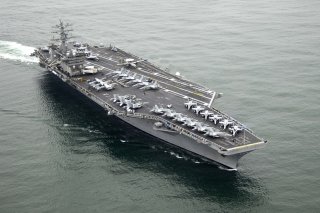Power Projection: Why the USS Nimitz Supercarrier Can Fight Anyone Anywhere
A total of ten aircraft Nimitz-class carrier ships have been built and the last of the class, USS George H.W. Bush, was commissioned in January 2009.
Here's What You Need to Know: The Nimitz-class aircraft carrier is unquestionably a symbol of American might and power projection abroad.
At 1,092 feet, the Nimitz-class supercarriers are more than three times the length of a football field, and with a crew of 3,200 sailors and 2,480 airmen, these are essentially floating cities. The lead ship of the class, USS Nimitz—nicknamed "Old Salt"—was commissioned in May 1975, was named after Adm. Chester Nimitz, who led the U.S. Navy through World War II.
The ship was first deployed to the Indian Ocean during the Iran Hostage Crisis and has since logged untold miles, providing security at the 1988 Seoul Olympic Games and later service in the Persian Gulf after Operation Desert Storm. Most recently USS Nimitz was deployed against ISIS in Iraq and Syria, where her F/A-18s took part in the Battle of Afar in 2017.
A total of 10 Nimitz-class carriers have been built, and the last of the class, USS George H.W. Bush, was commissioned in January 2009. These nuclear-powered carriers, which have two reactors and four shafts for propulsion with a top speed of 30+ knots (34.5mph), were the largest warships in the world until the USS Gerald R. Ford, the lead ship of her class of carriers entered service in 2017. Each of the Nimitz-class has an expected 50-year service life with one mid-life refueling. These warships, which have a displacement of 102,000 tons, were all built by Huntington Ingalls Industries Newport News Shipbuilding (now Northrop Grumman Ship Systems) based in Virginia at a unit cost of approximately $8.5 billion (constant year FY 12 dollars).
Each carrier has approximately 60 aircraft onboard and this includes a variety of fixed-wing and rotary-wing aircraft with up to 90 of various types. Typical aircraft on a Nimitz-class carrier include 12 F/A-18E/F Hornets, 36 F/A-18 Hornets, four E-2C Hawkeyes and four EA-6B Prowlers fixed-wing and helicopters, including four SH-60F and two HH-60H Seahawks. In addition, the carriers could also deploy the S-3B Viking, before these were phased out and replaced the F/A-18E/F Super Hornet. The flight deck, which measures 1,092 feet by 252 feet, is equipped with four lifts, four steam-driven catapults and four arrester wires. The carriers are capable of launching one air every 20 seconds.
The air wings of the carriers are customized according to the nature of operations, with the usual air wings replaced with 50 army helicopters on the USS Dwight D. Eisenhower for its operations in Haiti in 1994. Similar considerations can be made when a carrier is used for disaster response and humanitarian assistance.
In addition to the aircraft, the most recently built Nimitz-class carriers are now armed with three Raytheon GMLS mk29 eight-cell launchers for NATO Sea Sparrow surface-to-air missiles, which has semi-radar terminal guidance. There are also four Raytheon/General Dynamics 20mm Phalanx six-barreled Mk15 close-in weapons systems that have a 3,000rpm rate of fire.
While the last of the Nimitz-class carriers have been commissioned, and the class will eventually be replaced by the Gerald R. Ford-class, these ten carriers will still strike fear into potential U.S. adversaries for many years to come.
Peter Suciu is a Michigan-based writer who has contributed to more than four dozen magazines, newspapers and website. He is the author of several books on military headgear including A Gallery of Military Headdress, which is available on Amazon.com.
This article was first published several years ago.
Image: Wikimedia Commons

